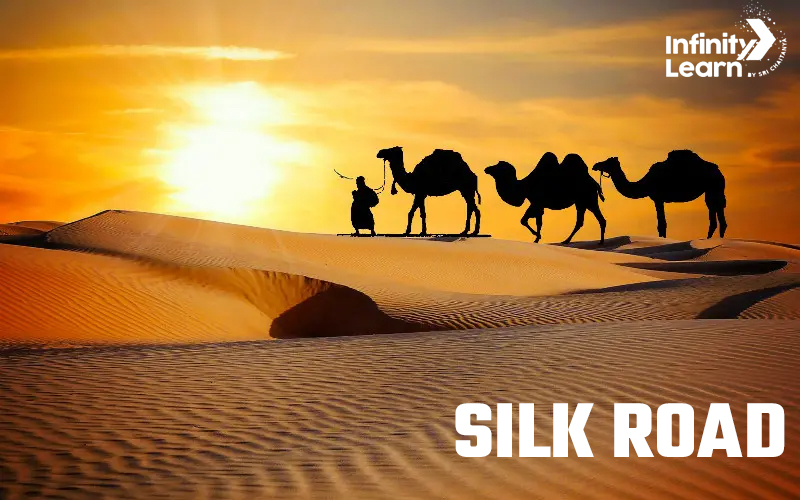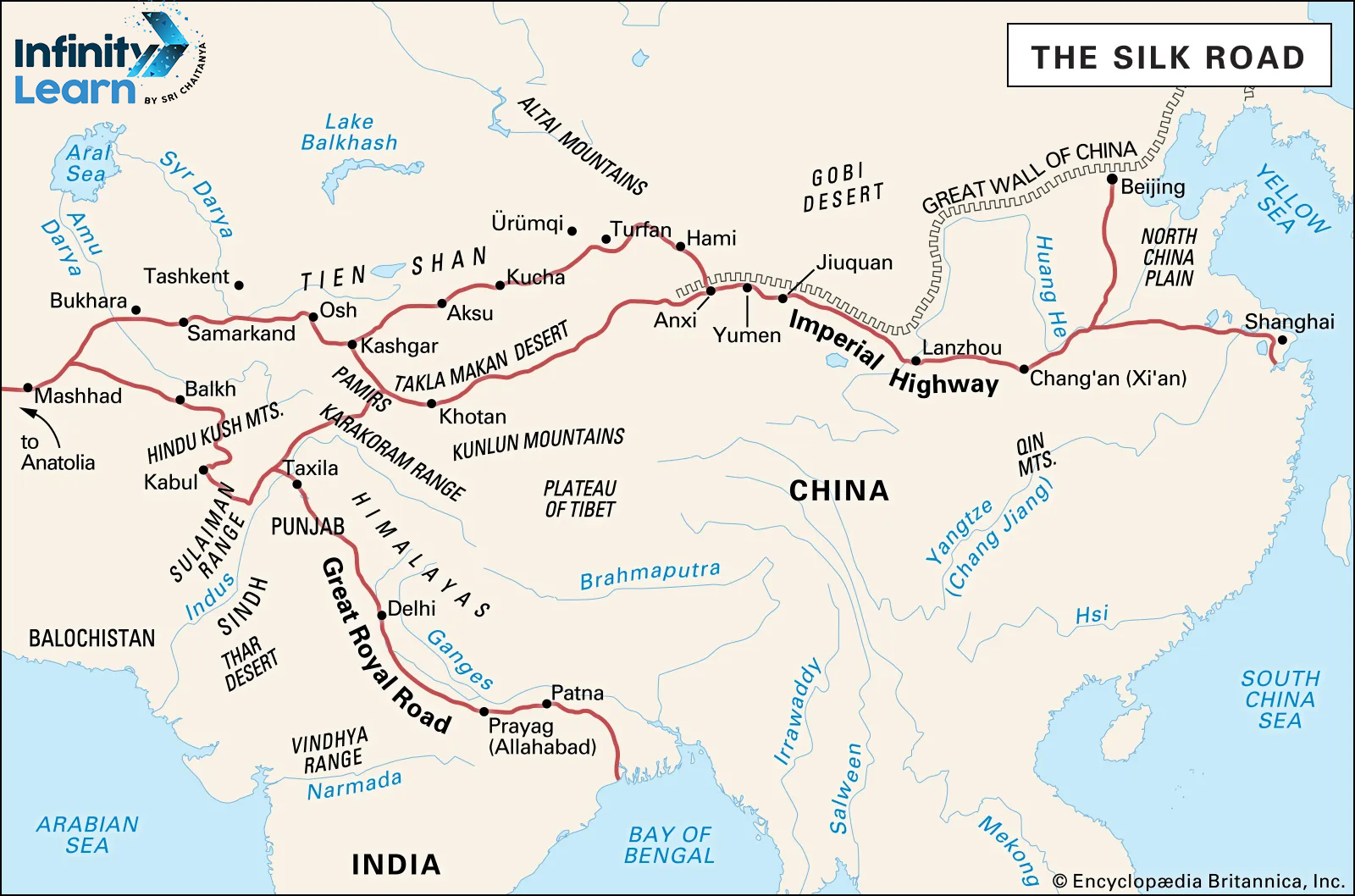Table of Contents
The Silk Road, known in Chinese as the “絲綢之路”, was an extensive network of trade routes that flourished from around the second century BCE to the middle of the 15th century. The Silk Road map interconnected regions of Eurasia and North Africa through land and sea routes, often regarded as the inaugural global trade route. The Silk Road transcended more commercial exchange; it facilitated the interchange of arts, religions, cultures, ideas, and technological advancements among diverse civilisations. The Silk Road also played a major role in spreading religions. It helped missions by Buddhist and European monks and was active in spreading Buddhism, Christianity, Islam, Hinduism, and other religions throughout the regions served by the routes.
Historical, Cultural, and Economic Significance
Historical significance: Over 1,500 years, the Silk Road linked the Western world with Asia and the Middle East. Its origins can be traced back to 130 B.C.E. when the Han dynasty of China initiated the trade, and it continued to be a vital trade route until 1453 C.E. when the Ottoman Empire ceased to trade with the West. Beyond facilitating the exchange of goods, the Silk Road played an important role in circulating ideas, cultures, religions, arts, and technology. Moreover, it contributed significantly to the spread of Buddhism, Christianity, Hinduism, and Islam across the interconnected regions.
Cultural: The Silk Road not only facilitated the exchange of goods but also served as a conduit for transmitting ideas, beliefs, languages, art, music, literature, and technologies between different civilisations along its vast network of trade routes. This cultural interchange enriched the societies involved and contributed to developing diverse cultures across Eurasia and beyond. Moreover, the Silk Road fostered the blending of traditions and the emergence of new cultural practices, leading to a dynamic and interconnected cultural landscape that endured for centuries.
Economic: The Silk Road Economic Belt is a land-based trade route that connects China with Europe and Central Asia. It is part of the Chinese government’s One Belt One Road initiative (BRI). The BRI also includes the 21st Century Maritime Silk Road, which connects China’s southern coast to the Mediterranean, Africa, and Central Asia.
The Silk Road Economic Belt revitalises ancient trading routes between Asia and Europe. The Silk Roads were important commercial routes for centuries, connecting prosperous areas like China and the Middle East. Commodities traded on these routes included silk, coral, pearls, glass, jade, gems, perfumes, and incense.

Silk Road Route
The Silk Road was a trade route that stretched from Asia to the Mediterranean from the second century B.C. to the 14th century A.D. The route was about 4,000 miles long and began in Xi’an, China. It stretched west along the Great Wall of China, across the Pamirs, through Afghanistan, and into the Levant and Anatolia. The Silk Road’s western endpoints included Byzantium (Constantinople), Antioch, and Damascus.
The Silk Road Map states that it was mostly a land route but included sea routes. The route connected China to Korea and Japan in the east, and through Central Asia to India in the south and to Turkey and Italy in the west. The Silk Road’s maritime section, the Maritime Silk Road, connected China to Southeast Asia, the Indonesian archipelago, the Indian subcontinent, the Arabian peninsula, Egypt, and Europe.
Revising Silk Road
In 2013, China launched the ambitious “One Belt, One Road” (OBOR) initiative, also known as the Belt and Road Initiative (BRI), under the leadership of President Xi Jinping. This initiative, backed by a $900 billion investment, aims to revitalise the historic Silk Route and enhance China’s connectivity with over 60 countries across Asia, Europe, and East Africa.
The Belt and Road Initiative have both land and sea routes, with the Silk Road Economic Belt focusing on land-based connections to link China with Central Asia, Eastern Europe, and Western Europe. Meanwhile, the 21st Century Maritime Silk Road prioritises sea-based routes, linking China’s southern coast with regions including the Mediterranean, Africa, Southeast Asia, and Central Asia.
China perceives the initiative as crucial to stimulating domestic economic growth and expanding its trade footprint by opening up new trade markets and streamlining the export process for Chinese goods. The initiative offers China an advantageous platform for material exports at competitive costs and with logistical efficiency.
Silk Road Map

Silk Road Importance in Trade
The Silk Road holds immense significance in trade history, serving as an important route that connected the East and the West for centuries. Stretching across vast expanses of Asia. The Silk Road facilitated the exchange of goods, ideas, and cultures between diverse civilisations along its intricate network of land and sea routes.
From luxurious silk and spices to precious metals and exotic commodities, traders passed across this ancient route, fostering economic prosperity and cultural enrichment. The Silk Road gave commercial activities and catalysed technological advancements and cultural diffusion, shaping history and laying the groundwork for globalisation.
Silk Road Control of the Kushanas
The Kushan state, founded in the first half of the 1st century AD, controlled the Great Silk Road for three centuries. The Kushan kingdom (30 B.C-375 A.D) controlled most of the Silk Road, including a direct road from Gandhara (present-day Afghanistan) to China. The Kushan Empire linked the seagoing trade of the Indian Ocean with the commerce of the Silk Road through the Indus Valley.
The Kushans had flourishing trade relations with Central Asia, China, and Western Asia. The export of goods meant the import of valuable trade commodities like horses, gold, and salt. The Kushans became more successful because of the trade that happened on the Silk Road. They also introduced the gold coin to the continent.
Spread of Buddhism Through the Silk Road
The ancient Silk Road facilitated the transmission of Buddhism from India to China during the period spanning from the first century BC to the seventh century AD. This network interconnected India, Southeast Asia, Central Asia, and China through land and sea routes. Buddhism, being the earliest major missionary faith, utilised the Silk Road to extend its influence beyond its place of origin.
Buddhism had disseminated from northeastern India to present-day Pakistan and Afghanistan by the first century BCE. It made its way into Han China via the Silk Road around the first or second century CE, with documented translation efforts undertaken by Buddhist monks in China during the 2nd century CE.
Although the Silk Road remained active until the 15th century AD, maritime trade eventually supplanted its dominance. Nevertheless, commercial interactions along the Silk Road contributed to the betterment of Buddhist monks’ conditions, with the concept of Dāna (generosity) encouraging the receipt of contributions from merchants and other participants in the Silk Road trade.
Decline of Silk Road
The decline of the Silk Road trade commenced approximately around 1360 AD. The devastating impact of the Black Death, a series of bubonic plague outbreaks roughly two decades earlier, considerably weakened the trade routes. Additionally, the disintegration of the Mongol Khanates and the emergence of sea routes from Europe to Asia in the late 15th century further contributed to the decline of the Silk Road trade.
Several factors played a role in the decline of the Silk Road trade:
- Political instability in the region.
- Economic transformations that altered trading patterns.
- Technological advancements favouring sea transportation.
- The efficiency and capacity of maritime transport.
- The cost-effectiveness of sea transport compared to land routes.
- The increasing prominence and safety of sea trade routes.
- The faster transportation of goods by ships compared to caravans.
FAQ on Silk Road
How did the Silk Road impact civilisations?
The Silk Road significantly fostered cultural exchange, technological diffusion, and economic prosperity among its connected civilisations. It facilitated the spread of religions such as Buddhism, Christianity, Islam, and Judaism and the exchange of scientific knowledge, art, and literature.
What led to the decline of the Silk Road?
Several factors contributed to the decline of the Silk Road, including the rise of maritime trade routes, political instability in certain regions, and the development of alternative trade routes. By the 15th century CE, maritime trade had largely supplanted overland trade along the Silk Road.
What did the Silk Road trade do?
The Silk Road traded a wide array of goods, including silk, spices, precious metals, gems, ceramics, textiles, and exotic animals. It also facilitated the spread of ideas, religions, and technologies.
What is Silk Road called now?
The Silk Road is now known as the Silk Route. It's not a single road but a network of historical trade routes connecting the East and West. Despite its ancient origins, the Silk Route remains a symbol of cultural and economic exchange between regions. Today, it inspires modern equivalents, like digital and international trade routes, continuing its legacy of connectivity.
What was the main point of the Silk Road?
The main point of the Silk Road was to facilitate trade and cultural exchange between different civilizations. It connected traders, merchants, pilgrims, monks, soldiers, nomads, and urban dwellers from China to the Mediterranean Sea, allowing them to trade goods, share ideas, and spread religions. Silk, spices, tea, and technologies were among the many items exchanged along these routes, enriching societies along the way.
Was India part of the Silk Road?
Yes, India was a significant part of the Silk Road. It acted as a central hub in the network, connecting the East with the West. India's strategic location allowed it to trade silk, spices, gems, and other valuable goods. Additionally, India contributed to the cultural and religious exchange, spreading Buddhism and other ideas across the Silk Road, highlighting its importance in the historical trade network.









